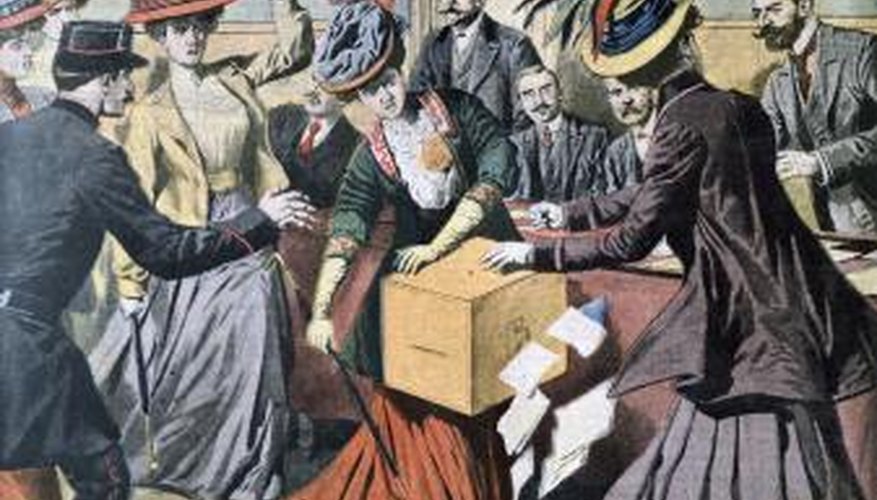The right to vote in America was at first extended only to white male landowners, but by the end of the 1830s had been extended to all white male citizens. The energetic and socially-active women of the United States believed this was not enough. In 1848, Elizabeth Cady Stanton and Lucretia Mott invited fellow abolitionists to Seneca Falls, New York to discuss not liberating slaves, but liberating women by giving them the power to vote.
History
While the Seneca Falls conference kicked off a women's suffrage movement that gained momentum throughout the 1850s, it was a cause that always competed with abolition. During the Civil War and the push for African-American citizenship and voting rights that followed, women's suffrage was all but ignored. However, Stanton and Susan B. Anthony argued against the passage of the 15th Amendment that guaranteed black men the right to vote, pointing out that a better amendment would give all adult American citizens that right. Though this caused a rift in the movement, it also revitalised it. By 1890, the National American Woman Suffrage Movement brought the fight into the public eye once more.
- While the Seneca Falls conference kicked off a women's suffrage movement that gained momentum throughout the 1850s, it was a cause that always competed with abolition.
Pros
While early activists argued that women deserved voting rights because they, like men, were created equal, the new movement in the 1890s argued that women deserved that right because they were different. The female agenda included items unpopular with men like temperance, and women during the Victorian age were viewed as more moral and virtuous. Female suffrage, activists argued, could bring about better and more moral laws. In the South, suffragists argued that allowing women -- specifically, white women -- to vote could dilute the black vote, already an item of great contention.
- While early activists argued that women deserved voting rights because they, like men, were created equal, the new movement in the 1890s argued that women deserved that right because they were different.
- In the South, suffragists argued that allowing women -- specifically, white women -- to vote could dilute the black vote, already an item of great contention.
Cons
The arguments of the anti-suffrage activists seem antiquated from a modern point of view. Women, they said, were physically frailer and could not handle the stress of voting -- both making the decision or mingling with the crowds of men at the ballot box. Women suffered from the curse of Eve, leading men into temptation and trouble, and would vote in a similar manner, leading countries to war. Women's votes would be easily swayed by husbands or unscrupulous politicians. A woman could hide extra ballots in her voluminous sleeves and skirts, and stuff the ballot box. Since she could not fight in wars, she could not make rational decisions about wars, and allowing women the vote could lead to women in power who might make decisions about war. Most importantly, however, they argued that women were incapable of logic and rational decisions, and their emotional natures would lead them to vote poorly.
- The arguments of the anti-suffrage activists seem antiquated from a modern point of view.
- Most importantly, however, they argued that women were incapable of logic and rational decisions, and their emotional natures would lead them to vote poorly.
Suffrage Height
In 1893, Wyoming was the first state to grant women suffrage, followed shortly by Idaho and Utah. After a long hiatus, more western states granted the vote; Washington, California, Oregon, Kansas, Arizona, Montana and Nevada all legalised women's suffrage between 1910 and 1914. While the eastern states were slower to follow, the dedication of women to the suffrage cause gradually won them over. By 1918, both Democrat and Republican parties supported women's voting rights.
- In 1893, Wyoming was the first state to grant women suffrage, followed shortly by Idaho and Utah.
- After a long hiatus, more western states granted the vote; Washington, California, Oregon, Kansas, Arizona, Montana and Nevada all legalised women's suffrage between 1910 and 1914.
19th Amendment
In 1919, the 19th Amendment was finally passed by Congress. Written by Susan B. Anthony and introduced into the House of Representatives in 1878, it simply stated that the right to vote shall not be abridged due to sex. It was sent to the states for ratification. On Aug. 18, 1920, Tennessee became the 36th and final necessary state to ratify the amendment. It was signed into law on Aug. 26, 1920.
- In 1919, the 19th Amendment was finally passed by Congress.
